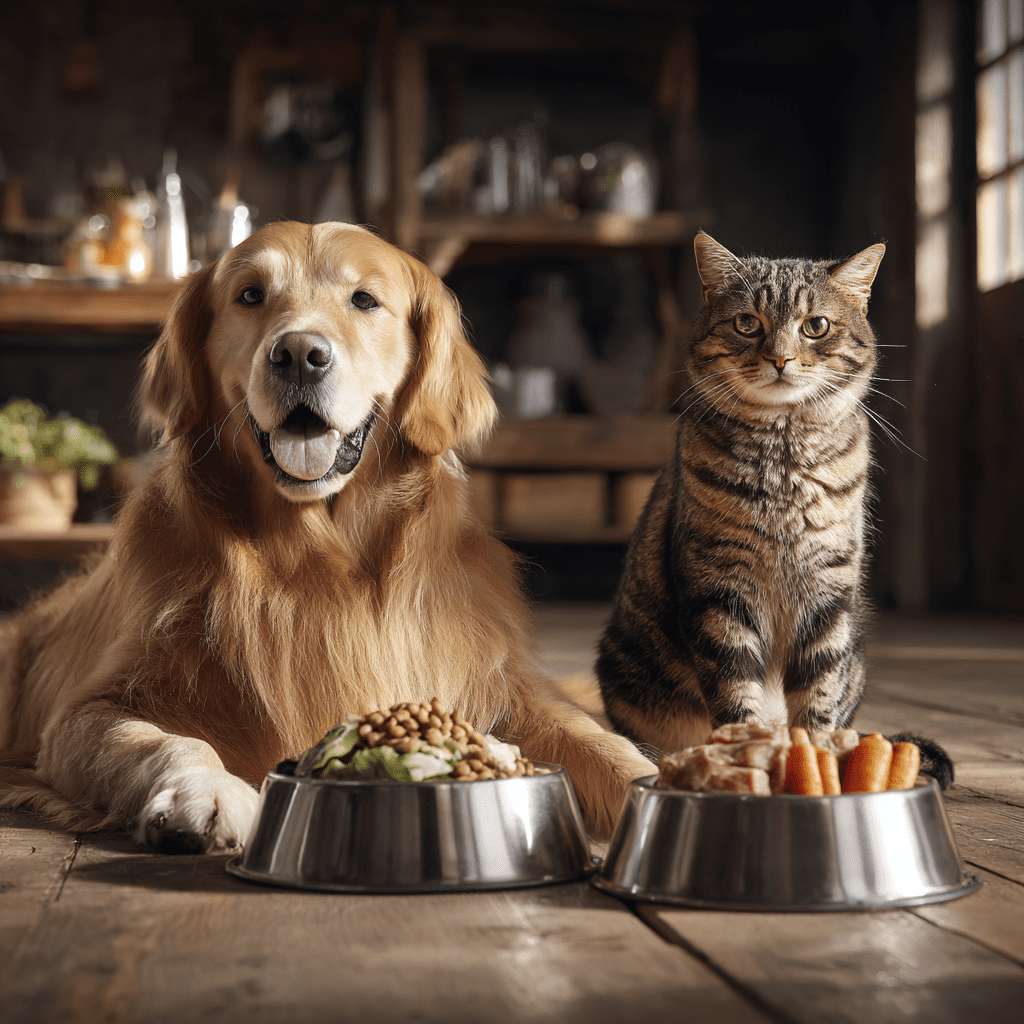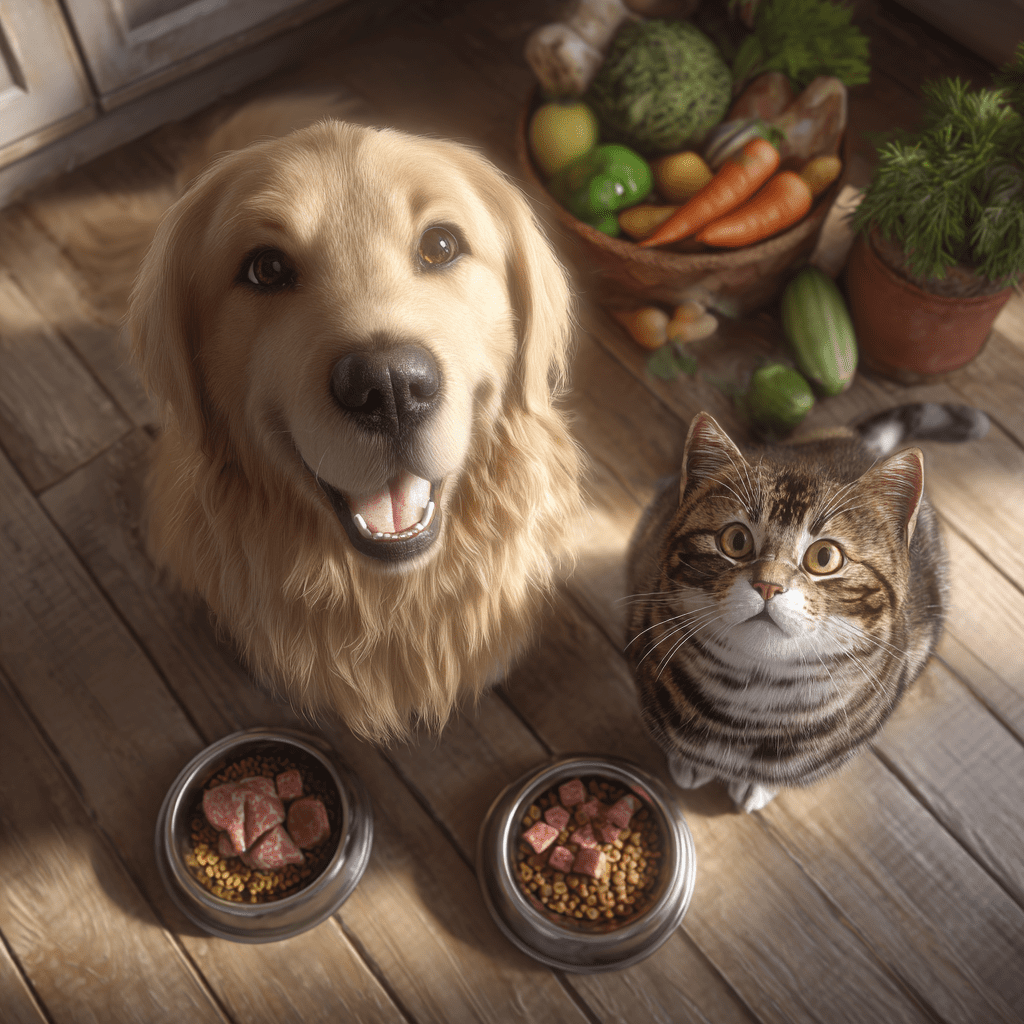Introduction: The Growing Trend of Raw Feeding
Over the past decade, raw food diets for pets—often called BARF (Biologically Appropriate Raw Food or Bones and Raw Food)—have gained massive popularity. Pet parents are turning to raw diets to mimic what wild ancestors of dogs and cats ate before kibble was invented.
But with popularity comes controversy. While some pet owners swear raw feeding transformed their pet’s health, many veterinarians remain cautious due to potential health risks, nutritional imbalances, and foodborne illnesses.
This guide dives deep into the benefits, risks, and safety precautions you need to know before considering a raw diet for your pet.
1. What Exactly is a Raw Pet Diet?
A raw diet typically consists of:
- Raw meat (chicken, beef, lamb, turkey, rabbit, fish).
- Raw bones (edible, non-weight-bearing bones for calcium).
- Organs (liver, kidney, heart, which provide vital nutrients).
- Vegetables and fruits (carrots, spinach, blueberries, pumpkin).
- Supplements (omega-3 oils, probiotics, vitamins).
Some pet owners prepare raw meals at home, while others buy commercial raw pet food that is pre-packaged and frozen.
2. Claimed Benefits of Raw Diets for Pets
Supporters of raw feeding highlight several benefits:
a) Improved Coat and Skin
Raw diets often contain higher levels of omega fatty acids, which can lead to shinier coats and reduced skin irritations.
b) Better Digestion
Some pets experience firmer stools and less bloating due to the absence of fillers and processed grains.
c) Increased Energy
Owners report their pets being more energetic and active, likely from higher protein intake.
d) Cleaner Teeth
Chewing raw meaty bones may help reduce plaque and tartar buildup.
e) Weight Management
Raw diets tend to be higher in protein and lower in carbs, which can help manage obesity in pets.
3. Potential Risks of Raw Feeding
Despite the positives, raw diets aren’t without risks:
a) Bacterial Contamination
Raw meat can carry Salmonella, E. coli, and Listeria, which may infect not only pets but also humans in the household.
b) Nutritional Imbalances
Without proper planning, a raw diet can lack essential nutrients like calcium, vitamin D, or taurine, leading to deficiencies.
c) Bone Hazards
Whole bones can cause choking, tooth fractures, or intestinal blockages.
d) Expense and Storage
Raw feeding can be costly and requires freezer space and careful handling.
e) Not Suitable for Every Pet
- Puppies/kittens, seniors, or immunocompromised pets may struggle with raw diets.
- Pets with kidney or liver disease may require specialized nutrition.
4. Scientific and Veterinary Perspectives

Most veterinary associations, including the American Veterinary Medical Association (AVMA), urge caution with raw diets due to bacterial risks and incomplete nutrition if improperly balanced.
However, some holistic veterinarians support raw feeding when done responsibly and under professional guidance.
5. Safety Tips for Feeding Raw Diets
If you decide to try a raw diet for your dog or cat, follow these crucial safety practices:
a) Work with a Vet or Nutritionist
Ensure your pet’s meals are nutritionally balanced for their breed, age, and health.
b) Practice Safe Food Handling
- Wash hands, bowls, and surfaces thoroughly.
- Store raw food at proper freezer/refrigerator temperatures.
c) Choose High-Quality Meat
Buy from trusted suppliers and avoid meat treated with harmful preservatives.
d) Supplement Correctly
Consider adding:
- Calcium (if not feeding bones).
- Omega-3 oils for joint and skin health.
- Taurine for cats (critical for heart and eye function).
e) Avoid Dangerous Foods
Never include cooked bones, onions, grapes, raisins, chocolate, or xylitol in meals.
f) Introduce Gradually
Switching to raw overnight can upset digestion. Transition over 7–10 days.
6. Alternatives to Raw Diets
If you like the idea of less processed food but worry about risks, try:
- Freeze-dried raw food – Removes moisture but keeps nutrients intact.
- Gently cooked diets – Lightly cooked meals with balanced nutrition.
- High-quality commercial fresh food – Refrigerated options like Farmer’s Dog or Nom Nom.
7. Raw Diets for Dogs vs. Cats
Dogs
- More adaptable to varied diets.
- Can handle raw bones better.
- Benefit from a mix of meat, bone, organs, and some plant matter.
Cats
- Obligate carnivores – must eat meat.
- Require taurine, vitamin A, and arachidonic acid (which only come from animal sources).
- Should not be fed large bones.
8. Signs a Raw Diet Might Be Working for Your Pet
- Healthy body weight.
- Firm, smaller stools.
- Shiny coat.
- Steady energy.
If you notice vomiting, diarrhea, lethargy, or weight loss—reassess immediately.
9. Real-Life Success Stories
Many pet owners share transformations after switching to raw diets:
- Dogs with skin allergies showing improvement.
- Cats with digestive issues producing less odor in litter boxes.
- Overweight pets reaching healthy weights.
Still, these are anecdotal and not guaranteed results.
10. Is Raw Feeding Right for You and Your Pet?
Ultimately, raw feeding is a personal choice. It requires:
- Time and effort in preparation.
- Strict hygiene practices.
- Financial commitment for quality ingredients.
If done carefully with veterinary supervision, raw diets can work. If not, they may cause more harm than good.
Conclusion: Balance is Key
Raw diets are neither a miracle cure nor inherently dangerous—they’re simply another feeding approach. The key lies in knowledge, preparation, and safety.
For some pets, raw feeding can lead to better health, energy, and longevity. For others, traditional kibble or cooked diets may be safer and more practical.
